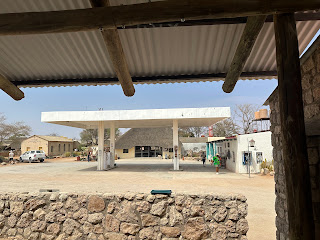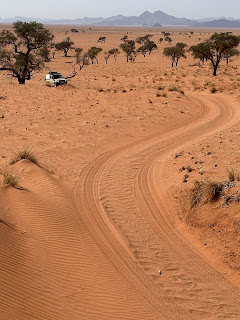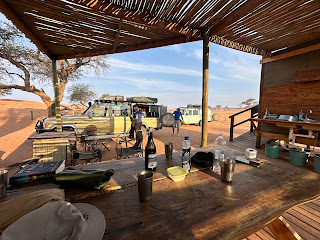 |
| Nossob 4x4 Eco Trail, South Africa 2024. |
 |
| Nossob 4x4 Eco Trail, South Africa, 2024. |
Before departure
After a delightful drive from Kalahari Tented Camp, which is located just within the Mata Mata border crossing from Namibia to South Africa in Kgalagadi Transfrontier Park, we drive via Upper Dune Road to Nossob Rest Camp, where we are to meet the other participants for the Nossob 4x4 Eco Trail. Together, we will embark on four days (three nights) of challenging 4x4 driving along a narrow track through the Kalahari dunes, accompanied by a certified guide from SANParks. We will cover a total distance of 214km, with daily travel spanning approximately 50km to 60km.
I wonder who the other participants are? You get close to one another on such a trip, where you spend all your time together without any "escape routes" in the middle of the desert. However, based on our experience from many previous trips to Africa, it’s usually other like-minded and interesting people, who, like us, enjoy nature and an exciting challenge. It’s not exactly the charter tourist segment that joins this kind of expedition.
At the reception in Nossob Rest Camp, we are assigned our campsite, where participants gather the day before departure. Arriving at the campsite, we immediately meet the first couple from South Africa, among others who will be joining the tour. They come over right away, warmly welcoming us and asking if we wouldn’t bring our chairs and sit with them after we’ve set up the rooftop tent. It quickly turns out that they are incredibly nice people, and we end up having a great time together throughout the expedition.
 |
Arrival at Nossob Rest Camp before Nossob 4x4
Eco Trail, my wife opens the gate!
South Africa, 2024. |
Three more vehicles from South Africa join us shortly after. They are also very friendly people, part of a larger family group who are on the trip together – a really great idea.
In the evening, just before sunset, our guide from SANParks (South African National Parks), Thys Burger, stops by to say a quick hello. He informs us that we should be ready for a briefing and departure the next morning at 8:30 AM.
 |
Ready for morning briefing before our 4 days
/ 3 nights adventure at Nossob 4x4 Eco Trail,
South Africa, 2014. |
The morning briefing proves to be a regular start to the day's program. Thys informs us about the route and safety. Always in a friendly and welcoming tone, engaging everyone, but leaving no doubt that he is in charge of the trip. For instance, the rules are: leave only footprints, always stay on the track, no music in the camp, remember sturdy shoes due to snakes and scorpions, etc. When we arrive at a camp or get out of the vehicles, the rule is that Thys always checks the area for dangers before we all step out. This is particularly about cats (hyenas, leopards, and lions). Thys always carries a rifle, and on previous expeditions, there have been large cats in the camps. After dark, if anyone needs to go to the long-drop toilet, they must wake Thys. No one walks alone in the dark. After dark, you must be especially cautious. For example, there are around 470 lions in Kgalagadi(!)
 |
Lion on our way from Kalahari
Tented Camp to Nossob rest Camp
to join Nossob 4x4 Eco Trail,
South Africa, 2024. |
Lastly, we are all given radios so we can communicate while driving. Every day, the cars switch positions, with the front vehicle moving to the back. This way, everyone gets to drive both at the front and back. In practice, the order doesn’t matter much. Everyone can see everything – and there is plenty of intense 4x4 driving!
 |
All got radios for communication,
Nossob 4x4 Eco Trail,
South Africa, 2024. |
Day one / Swartbas Camp
 |
1. day, on the way to Swartbas Camp,
Nossob 4x4 Eco Trail,
South Africa, 2024 |
From Nossob Rest Camp, we drive approximately 70 km north along the dry riverbed, where we catch the beginning of the trail. In odd-numbered months, the route is driven from north to south, while in even-numbered months, it's the opposite. As soon as we turn onto the trail and head south, we sense that we are now driving in a place where no one else will pass for the next 214 km! The desert views and dunes are breathtaking in every direction. Along the way, we make "discussion stops" where Thys tells us about the nature and wildlife of the Kalahari Desert. It’s incredibly fascinating to hear his stories, which reflect his deep knowledge and experience.
Nossob 4x4 Eco Trail, 1st day driving
After several hours of driving, we reach the first camp, Swartbas, which is sheltered by low dunes and has lovely shade trees. Everyone chooses a spot to park and set up their tents, but only on the condition that Thys can see your camp from his own tent. Read this interesting previous post about a leopard entering a rooftop tent (link post)!!
In the center, there are shade trees and a concrete slab designed for a braai (grill). Everyone grills in the same spot, and it creates a cozy atmosphere.
 |
| Our camp at Swartbas |
About 50 meters away, there's an enclosure with a long-drop toilet, offering a free view of the bushes and desert while you do your business. There’s also an enclosure for a bucket shower. You heat up some water in a black bag using solar energy if you want a shower. The bag is then hung on a hook—again, with a clear view. You’re not allowed to shower after dark, for safety reasons due to the big cats. No one wants to break this rule. Flashlights scan the dark surroundings, searching for eyes in the night.
 |
Swartbas long drop toilet with a view,
Nossob 4x4 Eco Trail,
South Africa, 2024. |
We've parked our Land Cruiser a bit off to the side of the camp (but still within Thys's line of sight). In the evening, the moon rises before the sun sets, and there's the most spectacular sunset. Everyone gathers around the fire, grilling meat and vegetables, sharing stories from the day. We exchange experiences from the Kalahari Desert, South America, and Denmark. It’s incredibly exciting to gain insight into others' lifestyles in this way, intensified by the desert night and its sounds. Tonight, we don’t hear any dangerous animals and sleep peacefully.
 |
Our Land Cruiser a bit off to the side of the Swartbas Camp,
Nossob 4x4 Eco Trail, South Africa, 2024. |
 |
Everyone gathers around the fire,
Nossob 4x4 Eco Trail,
South Africa, 2024 |
Day two / Rosyntjiebos Camp
The next day, we pass by a large "pan," a depression in the desert terrain where water collects the few times it rains. Here, we take a lunch break with a view, and as always, Thys keeps the rifle close at hand. Lunch breaks are yet another opportunity to exchange stories from the Kalahari and around the world.
 |
Lunch break near large pan on the right, Kgalagadi
Transfrontier Park, Nossob 4x4 Eco Trail,
South Africa, 2024 |
Big Bertha Dune
After lunch, we face the highest dune on the entire trip, called "Big Bertha." It’s a challenge that everyone who has driven the Nossob 4x4 Eco Trail knows. Thys explains, before we tackle the towering dune, we need a good run-up with the car, preferably over 60 km/h, before starting the ascent in the soft sand!
 |
The others are waiting for the "Danish couple"
on the top of Big Bertha while I am discussing
the best strategy. Nossob 4x4 Eco Trail,
South Africa 2024. |
We’re driving a very heavy Toyota Land Cruiser, loaded for a six-week trip in Africa, and I must admit that I don’t want to risk taking the sharp turn just before the dune at 60 km/h – despite trying five times! Once, we stranded just five meters from the top (video below). If the car slides in the curve before the dune and hits the high sand ridge on the side of the track, there’s a high risk that it could roll over with all the luggage, including diesel, water, and supplies for six weeks. It’s an unnecessary risk to take. If it had been life or death, I could have approached the dune directly without the turn, but that would mean making new tracks in the desert, which isn’t allowed, as the rule is no new tracks. Alternatively, we could have unloaded all the luggage, tackled the dune, and then fetched the baggage on foot! Instead, we take the detour around "Big Bertha," avoiding the long, steep dune. It's all the same. Only a few light bruises to my pride, but it was the only challenge we had to bypass among the many major 4x4 off-road adventures on the trip.
Nearly reaching the top!?
After Big Bertha, we spot many interesting plants at our “discussion stops,” and hear stories about the Bushmen and hyena droppings!
 |
Our fantastic guide! Thys Burger from
SANParks. Nossob 4x4 Eco Trail,
South Africa, 2024. |
Spotted hyenas in the camp!
Finally, we reach the second camp, "Rosyntjiebos," which is very open in the landscape so that animals can’t sneak in. Nevertheless, a previous group had a visit from four lions at once. That information made all of us extra alert in the evening. Luckily, one of the other participants on the trip declared, "We must keep Doc (my nickname) alive." I thought that was a brilliant idea ;-) Save the doctor for last.
 |
Rosyntjiebos Camp, Nossob 4x4 Eco Trail.
South Africa, 2024. |
At 5:10 AM, we’re suddenly awakened by two spotted hyenas in our camp. I am startled awake by their loud howls, not to mention Thys’ loud shouts to scare the hyenas away. It was undeniably a rude awakening – but also exciting in its own strange way. Afterward, my wife and I fell back to sleep again – though I waited to pee until it was fully light, even though it was much needed!
 |
Hyena tracks around our camping
table and car in Rosyntjiebos Camp.
Nossob 4x4 Eco Trail, South Africa 2024. |
In the morning, we find hyena tracks around our camping table and car, and the hyenas have torn apart a towel. I ask Thys what wild animal he least wants to encounter in the camp? I would have guessed leopards. But Thys' ranking is spotted hyenas, leopards, and lions. Spotted hyenas are very cunning in the way they hunt in packs. They chase in coordination from multiple directions.
Day three / Witgab Camp
Last dark Green spot.
A new day full of exciting experiences on the way to Witgab Camp. Among other things, we hike to the top of a large dune, where we can overlook the most beautiful hilly desert landscape with scattered bushes and a few trees. Thys calls the view "Little Serengeti." Shortly after we continue driving, we pass a gemsbok that had been killed by two lions the week before. There is almost nothing left but the skeleton. When Thys was driving through the trail a week ago, the lions were lying in the way, blocking the road!
 |
gemsbok that had been killed by
two lions the week before. |
The landscape gradually changes, and it is now characterized by more uneven, scattered dunes, in contrast to the long dune ridges running NNW-SSE, which can stretch up to 200 km long. The more varied dunes make for some fun 4x4 driving experiences. You need all the gears. I prefer driving in L4 but only engage the differential lock a few times. Some drive in 4H and use fewer gears.
Scattered dunes driving
When we reach Camp 3, we spot lion tracks! Lions had visited the day before. We set up our tents/vehicles in a horseshoe-shaped ring, all with a view of a waterhole.
 |
Lion track Witgab Camp at arrival.
Nossob 4x4 Eco Trail,
South Africa, 2024 |
Once again, there’s a long drop toilet and bucket shower, but this time the bucket shower is hidden behind a dune, so the camp isn’t visible – a bit eerie when you want a bath, in case a big cat sneaks up and no one can see it. On the other hand, the view from the shower is incredible, and just like the other showers, it’s completely open on one side.
In the evening, there’s a bit of a melancholy feeling around the campfire, as it's the last night on the Nossob 4x4 Eco Trail. Thys makes the most delicious bread rolls over the fire, which we enjoy with a view of the most beautiful full blood moon over the camp and desert.
 |
Campfire Witgab Camp,
Nossob 4x4 Eco Trail,
South Africa, 2024. |
Just before bedtime, we hear lions and quickly rush to pack up for the night until Thys later informs us (!) that it was just an ostrich. Sounds can be deceiving.
The trail ends about 40 kilometers north of Twee Rivieren Rest Camp. Before that, we enjoy yet another beautiful drive, with a lunch break on the edge of a dune under a giant shepherd tree, whose roots impressively reach 65 meters into the ground!
 |
Blog author and wife under giant shepherd tree,
Nossob 4x4 Eco Trail, South Africa, 2024. |
The Nossob 4x4 Eco Trail fully lived up to our expectations, not least due to the pleasant and knowledgeable ranger, Thys Burger. We will never forget him and this trip and will look back on it with great joy. We hope to return again – this time with a larger family or group of friends! Highly recommended!



























































